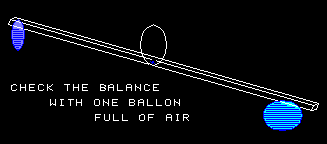 and
and  licensed under a Creative Commons Attribution-ShareAlike 4.0 International License.
licensed under a Creative Commons Attribution-ShareAlike 4.0 International License. and
and  licensed under a Creative Commons Attribution-ShareAlike 4.0 International License.
licensed under a Creative Commons Attribution-ShareAlike 4.0 International License.
PRINCIPLES OF ALCHEMYAIR
Do this! |

All right! My first "Do This!" Are we going to smash atoms together and transmute elements?

Get a long, thin piece of wood (2 feet long, or so). Use a ruler to find the center and mark it with a pencil. |

|
Push a tack into each side of the wood at the center. They will act as a pivot for the balance. |

|
Use drawing pins or anything that will give you a pair of "nubs" sticking out from the wood's center. Then make a loop of string and fix it around the pins. You could use a large rubber band. |

|
Yes. Exactly. If it isn't level, tape a coin or small bit of something on the higher end of the stick to make it balanced. It should be flat and level. |

|
Now, tape a balloon at each end of the wood. And check again to
see that the wood is still balanced.
|

|
Remove one balloon (but mark where you had it taped to the wood)
and blow it up.
|

|

Course | Syllabus | Asked Questions | Homepage |
 and
and  licensed under a Creative Commons Attribution-ShareAlike 4.0 International License.
licensed under a Creative Commons Attribution-ShareAlike 4.0 International License.